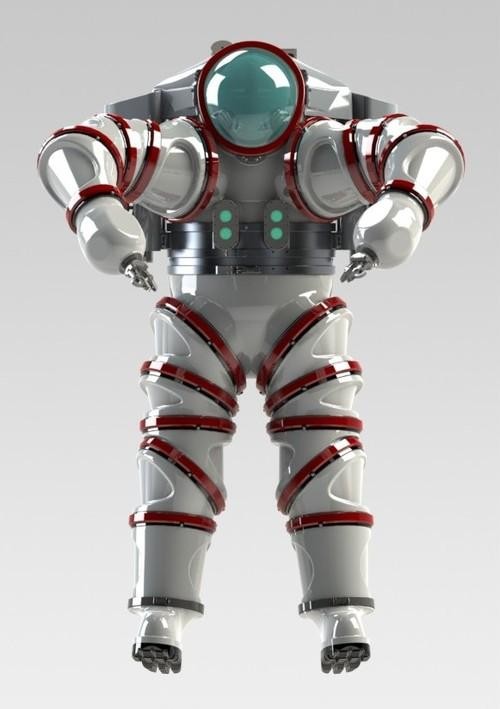This $1.3 Million Exosuit Will Plunge Scientists to the Depths of the OceanAlyssa Bereznak Feb 28, 2014

On Thursday, the American Museum of Natural History unveiled the “Exosuit,” a diving system that scientists hope will broaden their ability to study unknown species of bioluminescent and biofluorescent creatures at the depths of the oceans, instead of having to bring them up to the surface, as is the standard practice.
According to the scientists behind the project, the light communications of these little-studied specimens may offer new, valuable insight for biomedical research related to cancer cell tagging and the study of brain activity.
Measuring at about 6½ feet tall and weighing more than 530 pounds, the contraption can safely carry a human diver 1,000 feet below the water. At that depth, an unprotected human would be subjected to about 30 times the normal surface pressure.
The suit itself took about 15 years to develop. It is an update of the 1979 diving system known as the “JIM suit.”
 The JIM suit, courtesy of Wikipedia Commons
The JIM suit, courtesy of Wikipedia CommonsThe modern-day Exosuit cost about $600,000 to make and comes with an action figure’s list of cool accessories: a fiber-optic tether, topside control instrumentation and a custom-made remotely operated vehicle (aka a DeepReef-ROV) to aid with fish data collection. The entire set of equipment cost about $1.3 million to build.
What sets it apart is the ease with which scientists can move around in it underwater. Divers can rotate the suit’s limbs thanks to its red, oil-filled rotary joints. Each hand pod (which is connected to a claw), has a manipulator, which project coordinator Michael Lombardi says are relatively easy to control.
“It can be rather difficult, but also very intuitive,” Lombardi, who is also the museum’s dive safety officer, said at the presentation. “We did a training exercise in July, and an individual with very little dive experience, after about an hour in the suit, was able to pick a dime up off the ground. At first glance, this is a big, clunky thing; you think, how could you possibly do anything delicate? But to pick up a dime — there’s also no reason that we also can’t collect a delicate jellyfish down the road.”

The suit allows researchers to work below water for up to five hours and will come with a collection of specially modified hand tools: jars, bags, scalpels, syringes and a special suction device to capture animals. The idea is to carefully tease these delicate specimens into a container that can then be placed in front of a sophisticated camera for imaging.
“They’re very delicate, gelatinous things, so the idea of dragging them up is not very nice,” Vincent Pieribone, the project’s chief scientist, said at the unveiling. “They come up and they don’t look so good. So if you can imagine the ROV sitting in this environment in the water at night all on its own and the suit moving around collecting creatures that are moving by, sort of gently coaxing them into a container and then placing that in the front of a dark tube which contains a very sensitive camera, putting them at the exact focal point for imaging. Then the operators could run various routines of flashing lights to stimulate the organisms to get a bioluminescent response.”

According to Pieribone, who is a researcher at Yale’s John B. Pierce Laboratory, being able to study the response of these specimens may allow his lab to read out the electrical activity of a brain structure of an organism without ever touching it. Eventually, he hopes to develop this information to create brain-machine interfacing for individuals who have had injuries or damage to their nervous system. “These animals hold the key to that,” he said.
This July, a team of researchers will travel 100 miles off the New England coast to explore an underwater geographic region nicknamed “The Canyons,” an area of particular interest because it drops to depths of more than 10,000 feet. Using the suit, divers will have access to animals that migrate through this zone at night. The ROV will be outfitted with three to 10 cameras (one of which is a low-light camera; another is used to look at neurons). The goal is to capture these species as they generate visible light through chemical reactions in their organs and submit that information to the computers outfitted in the ROV via the fiber cable connected to the apparatus. Previous research was limited because these species were able to be studied only after being removed from the ocean via trawl nets or being recorded with remote instruments.
“The history of going down beneath the water starts with romantic ideas of treasure hunting and shipwrecks,” Baruch College marine biologist David Gruber said at the presentation. “As scientists, we’re also trying to get down there. But we’re really only seeing the skin of the ocean. To get there, we need to design these tools. The Exosuit is our tool.”
The Exosuit will be on display at the American Museum of Natural History from now until March 5. https://www.yahoo.com/tech/this-1-3-million-exosuit-will-plunge-scientists-to-the-78111107272.html